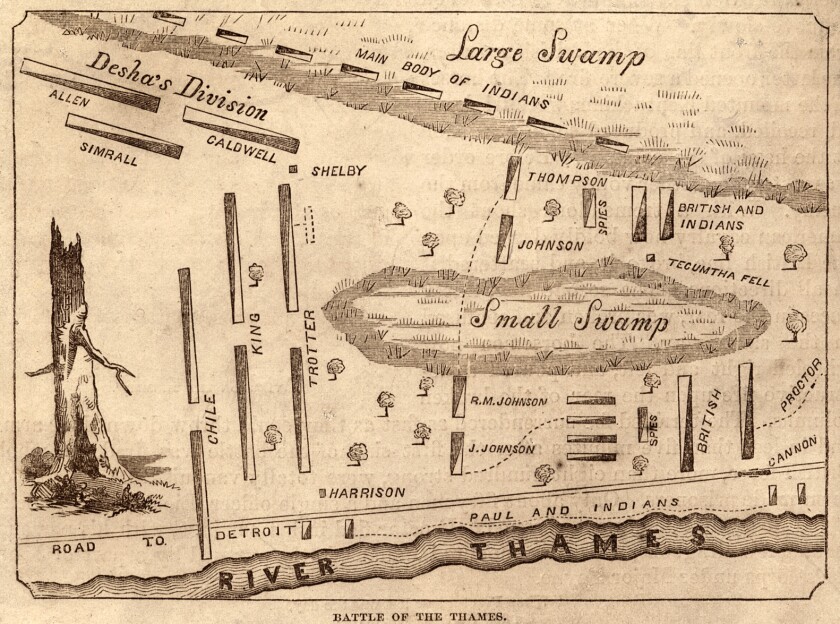Many of my Johnson relatives and in-laws have served in the United States military, including World War II, Korean War, Vietnam War, Gulf War, Desert Storm, and in peacetime. They had the good fortune to serve and return home to their families throughout most of our country’s wars.
However, one of our ancestors was not so fortunate.
The direct ancestor of all the Johnson descendants of Poplar Township in Cass County, Minnesota, was a likely Virginian named William Peter Johnson — my fourth great-grandfather Johnson.

There is not a lot known about William Johnson at this point, other than his sons, his frontier travels and service in the War of 1812 — defending the United States against the British Army and the Tecumseh Confederacy.
William and his elder brother, Walter Johnson, were born in colonial America, likely in Virginia, in the early 1760s. The brothers grew up and were teenagers during the American Revolution.
William married a woman named Isabel (unknown surname) in Virginia in the mid-1790s and fathered two children: Mary in 1796 and Jesse in 1797, the first son who is the direct ancestor of all the Johnson descendants in Poplar Township. William later remarried a second wife (unknown name) in the 1800s, and his third son, Hosier, was born in Maryland in 1810.
By 1811, William, his second wife and family had moved to southeastern Ohio, where his third son, Peter William Johnson, was born in Morgan County, which was then part of Washington County in Ohio.

A year later, the War of 1812 — the “Second War of Independence” — erupted between the United States and Britain and its Native American allies with their attacks on the Northwest Territory’s frontier. Due to those Native attacks on the frontier, Kentucky and Ohio communities formed volunteer militia companies to protect their families and fight the British and the Tecumseh Confederacy.
ADVERTISEMENT
By mid-1813, William Johnson and his family lived near Columbus, Ohio, where militia troops and U.S. Army regulars were rendezvousing in the summer to prepare and train for a campaign into the northern half of the Northwest Territory.
William Johnson joined a militia regiment of mounted infantry volunteers under the command of Col. Richard M. Johnson of Kentucky. It is not known if our William Johnson was related to Col. Johnson, who would later serve as vice president to President Martin Van Buren.
As the Kentucky/Ohio militia marched off toward northern Ohio, William Johnson’s family gathered alongside the road to see their father and the militia troops pass by. William’s second wife held her 2-year-old son, known as Pete, aloft to see the troops and the wave of his father’s hand as they marched northward, according to Peter Johnson’s 1889 obituary.
Col. Richard Johnson's Kentucky/Ohio militia would join under the command of “Old Tippecanoe” Maj. Gen. William Harrison’s Army of the Northwest in northern Ohio. During Cmdr. Oliver Perry’s naval victory in the Battle of Lake Erie on Sept. 10, 1813, Col. Richard Johnson marched his 1,000 troops overland and recaptured Detroit without any fighting. After abandoning Detroit, British commander Maj. Gen. Henry Proctor and Shawnee Chief Tecumseh’s forces began retreating on Sept. 27, 1813, up the Thames River into Upper Canada.
Col. Johnson’s militia then began a 100-mile march over several days from Detroit northeastward into Upper Canada in pursuit of the British Regulars and Tecumseh’s First Nation forces.
Shortly after daybreak on Oct. 5, 1813, on the banks of the Thames River, the British ended their retreat and formed a battle line just north of the river, near present-day Chatham, Ontario. Tecumseh’s Native American warriors formed their line in the nearby swamp to the right (or north) of the British troops.

Maj. Gen. Harrison then ordered Lt. Col. James Johnson’s (Col. Richard Johnson’s brother) First Battalion to make a frontal attack on the British regulars with his mounted rifleman. Lt. Col. James Johnson’s cavalry faced one British fusillade before breaking through the British forces, who immediately began a disorganized retreat.
ADVERTISEMENT
As the British fled, Tecumseh’s forces continued their fight in the swamp. Col. Richard Johnson and 20 of his men from the Second Battalion then led a frontal charge, known as the “Charge of the Forlorn Hope,” against the Tecumseh forces within the swamp. Of the 21 men in the charge, 15 members of the “Forlorn Hope” were either killed or wounded, while Col. Richard Johnson himself received five wounds.
As the British fled, Lt. Col. James Johnson and troops then turned and joined the fighting in the swamp. As the American troops converged, Chief Tecumseh was killed and the Native American resistance soon dissolved and its fighters fled into the forest.
There were conflicting accounts of the American losses at the Battle of the Thames — between a dozen to 25 deaths and 25 to 50 wounded. Historian Samuel R. Brown states that there were 25 killed or fatally injured and 50 wounded in Col. Richard Johnson’s regiment alone.
Following the Battle of the Thames, the United States regained control of the Northwest frontier and the Detroit area remained quiet for the remainder of the war.
It was at the Battle of the Thames where our ancestor William Peter Johnson was wounded, according to family history. His son Pete Johnson’s obituary noted his father’s death on Oct. 13, 1813, likely from his wounds eight days after the Battle of the Thames. His son Jesse Johnson recalled his father’s death in family interviews prior to his own 1882 death.
ADVERTISEMENT
The reality is that the patriarch William Peter Johnson of Poplar Township’s Johnson clan fought in defense of his family and his country on Oct. 5, 1813, at the Battle of the Thames, was wounded and later succumbed to his fatal wounds.
Now, more than 211 years later, on Memorial Day 2025, we remember the ultimate sacrifice of William Peter Johnson and other Kentucky-Ohio Militia and Army of the Northwest troops who fought for liberty, their families and America at this turning point of the War of 1812.
Kelly Boldan is the site manager and editor of the West Central Tribune of Willmar. For Memorial Day, he remembers family history of a fourth-great-grandfather, who died from wounds suffered in a War of 1812 battle. Boldan can be reached at: editor@wctrib.com .









